[agentsw ua=’pc’]
Do you want to import post ideas from a CSV spreadsheet in WordPress?
A spreadsheet is a great way to capture your ideas for future posts, and then organize those ideas into a winning content marketing strategy. However, at some point you’ll want to turn those ideas into new posts in your WordPress dashboard.
In this article, we will show you how you can automatically import post ideas from a CSV spreadsheet in WordPress.
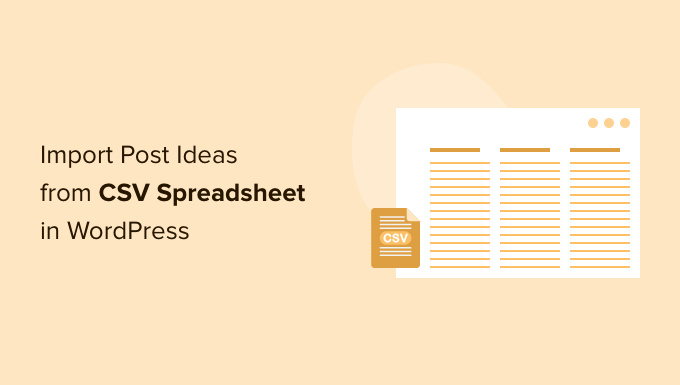
Why Import Post Ideas From CSV Spreadsheets in WordPress?
Many WordPress website owners plan their content in spreadsheets, where they add each post as a new row. You can even use a spreadsheet to record other information such as the tags the post will have, or who should write it.
A spreadsheet can be particularly useful if you’ve added other WordPress users or authors to your website and want to plan your upcoming content as a team. It’s also a way to make sure everyone knows exactly what they should be working on.
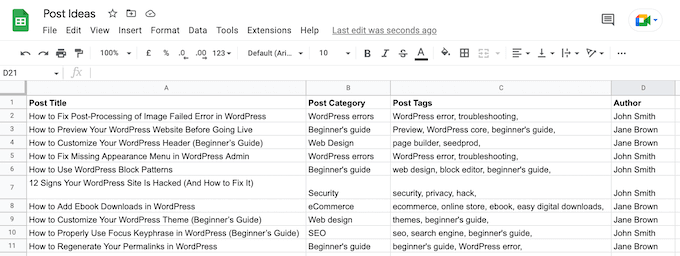
At some point ,you will want to turn these ideas into drafts in your WordPress blog, ready for you to start writing.
One option is to go into the Posts » Add New area of your WordPress dashboard, type in the post title, and then add more information from your spreadsheet, such as the post’s tags.
However this can take a lot of time, especially if your spreadsheet contains lots of post ideas. There’s also a chance you might make mistakes such as typos or duplicate posts.
Another option is to import post ideas from a CSV spreadsheet using a WordPress plugin. By automating the import process, you can save time while making sure all the information is imported into WordPress without errors.
With that in mind, let’s see how you can quickly and easily import post ideas from CSV spreadsheets in WordPress.
How to Import Post Ideas from CSV Spreadsheet in WordPress
The easiest way to import post ideas from CSV spreadsheets in WordPress is by using WP All Import. This plugin can automatically create a new draft for every post in your spreadsheet.
It also has a simple drag and drop interface that lets you map the different columns in your CSV spreadsheet to different content in WordPress. This means you don’t have to use any special labels for the columns in your spreadsheet, such as post_type or post_status.
But before we get started, it’s still a good idea to review your spreadsheet. If the CSV file has any wrong data, then this can cause problems with the import.
You should also think about whether there’s any more information you can add to the spreadsheet. For example, you might add a category to each of your post ideas.
This can save you time, as you won’t have to manually add this information to each post after it’s imported into the WordPress dashboard.
When you’re happy with the information in your spreadsheet, the next step is installing and activating the WP All Import plugin. For more details, please see our guide on how to install a WordPress plugin.
Upon activation, go to Import » New Import.
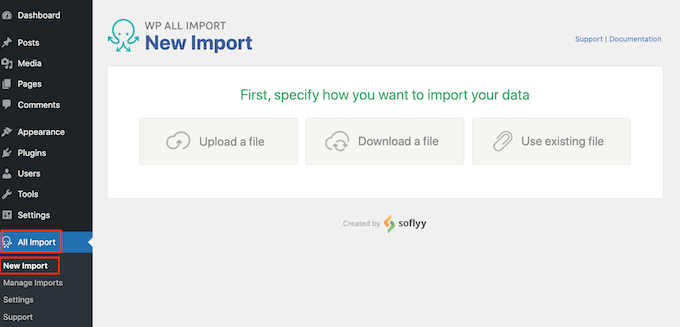
There is a WP All Import Pro plugin that lets you import CSV files in a few different ways, including using the file’s URL or importing the information via FTP. If you haven’t heard about FTP before, then you can see our complete guide on how to connect to your site using FTP for more information.
However, the free version of WP All Import just lets you import a CSV file from your computer. With that in mind, click on the ‘Upload a file’ button and then choose the CSV spreadsheet that you want to import.
WP All Import can create a new post for every row in your spreadsheet, or it can add the spreadsheet’s data to posts that already exist in your WordPress website.
We want to create a new draft for every post idea, so go ahead and click on ‘New Items.’
After that, simply open the ‘Create new’ dropdown and click on ‘Posts.’
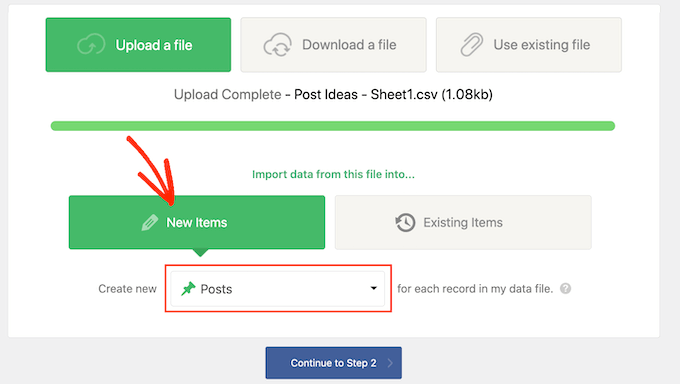
Once you’ve done that, go ahead and click on the ‘Continue to step 2’ button.
WP All Import will now show how many new posts it will create, and the data it will add to each post. You can scroll through these posts by clicking on the arrows.
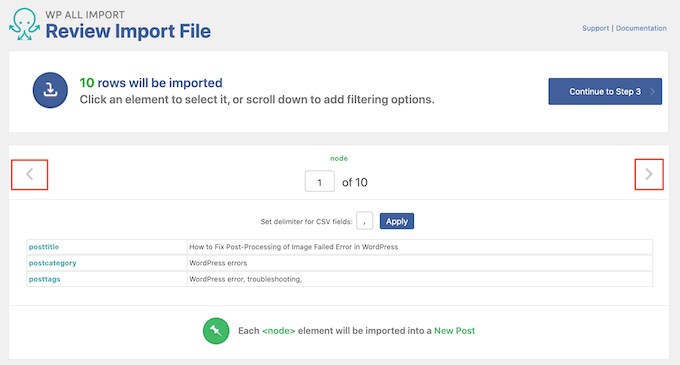
By default, WP All Import will import all the information from your CSV spreadsheet.
If you don’t want to import every idea in the spreadsheet, then you can create filters. For example, you might use a filter to only import post ideas that have a specific tag.
To create a filter, go ahead and click to expand the Add Filtering Options section.
You will now see some dropdowns and fields that you can use to create a filter. In the following image, we’re only importing post ideas that have the tag ‘Beginner’s guide.’
You may see different options depending on how you’ve organized your spreadsheet.

When you’re happy with your filter, go ahead and click on the ‘Add Rule’ button.
WP All Import will now create a filter. To apply this filter to your import, make sure you click on the ‘Apply Filters to XPath’ button.
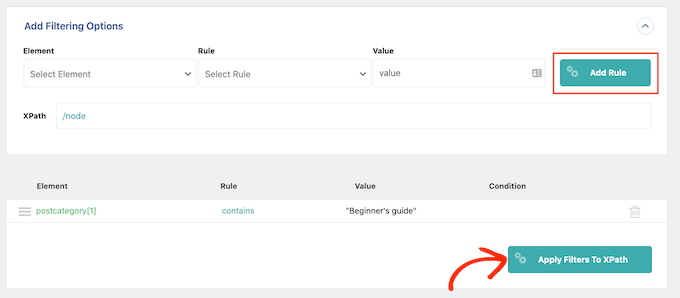
The post preview at the top of the screen will now update to show only the posts that pass your filter.
Want to add more filters to your import? Then simply follow the process described above.
If you do create multiple filters, then you can tell WP All Import to only import content that passes all your filters by clicking on ‘AND.’

Another option is to import any post ideas that pass one or more of your filters by clicking on the ‘OR’ radio button.
After selecting one of these options, go ahead and click on ‘Apply Filters To XPath.’ As before, you can use the preview to see exactly what posts WP All Import will create based on your spreadsheet and filters.
When you’re happy with the preview, scroll to the bottom of the screen and click on ‘Continue to Step 3.’
This will take you to a screen where you can map each column in your spreadsheet to an area of a WordPress post.
On the right-hand side, there is a box showing the different ‘categories’ of data that WP All Import will import for each post.
On the left are all the different areas where you can show this data, such as the post’s title, content, and the author byline if you’re running a WordPress multi-author blog.

To create the mapping, simply find a category of data in the right-hand box. Then, drag it to the area where you want to show this information in WordPress, and drop it into place.
In the following image, you can see that we’ve dragged ‘posttitle’ to the Title field. This means that this information will be used for the post’s title.
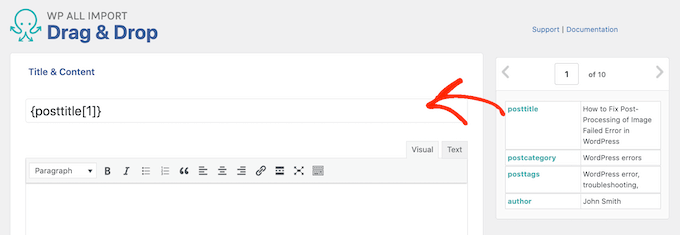
Sometimes you may need to take some extra steps to create the mapping. For example, to import category and tag information from a spreadsheet, you’ll need to click to expand the ‘Taxonomies, Categories, Tags’ section.
You can then check either the ‘Categories’ or ‘Tags’ box.

This adds some new settings where you can set up how WordPress will import the categories or tags from your spreadsheet. For example, you tell WP All Import to enforce one category per post in WordPress.
In the following screenshot, we’re telling WP All Import to import all the categories from the spreadsheet, even if it means a single post will have multiple categories.
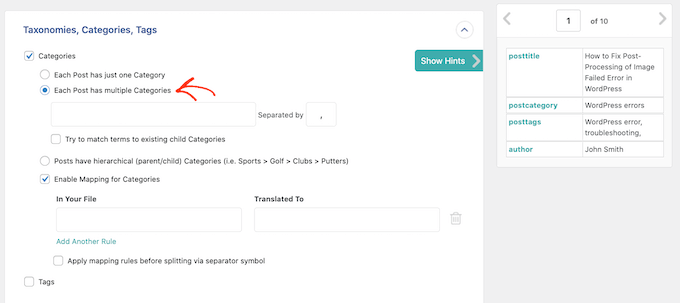
You’ll typically want to map the tags and categories in your spreadsheet, to any categories and tags that already exist in your WordPress dashboard. This stops WP All Import from creating duplicate tags and categories, which may change where your site appears in the search engine results.
To learn more about how categories and tags affect your search engine optimization, please see our guide on SEO best practices for sorting your content.
If you want the plugin to try and map the values in your spreadsheet to the existing categories & tags in WordPress, then please check the ‘Try to match terms to existing child Categories / Tags’ box.
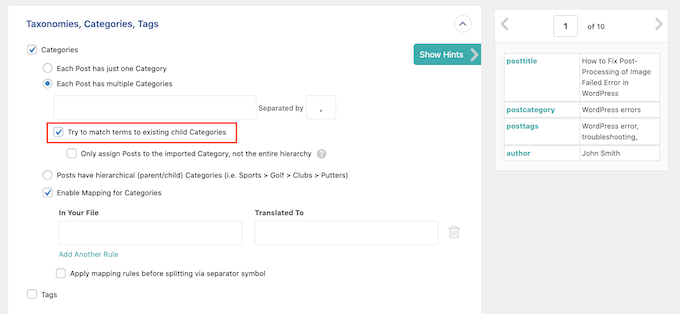
After that, simply find your spreadsheet’s category or tag value in the right-hand box.
Then, create the mapping using drag and drop.

Next, click to expand the ‘Other post options’ section.
WP All Import can either create the new posts as drafts, or go ahead and publish them. Typically, you’ll want to turn each post idea into a draft, so click on the ‘Draft’ radio button.
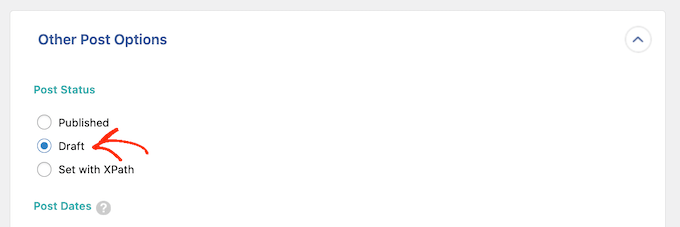
Once you’ve done that, you can choose whether to allow comments, and trackbacks and pingbacks on the posts.
For example, if you want to completely disable comments for your new posts, then simply click to select the ‘Closed’ radio button in the ‘Comments’ section.
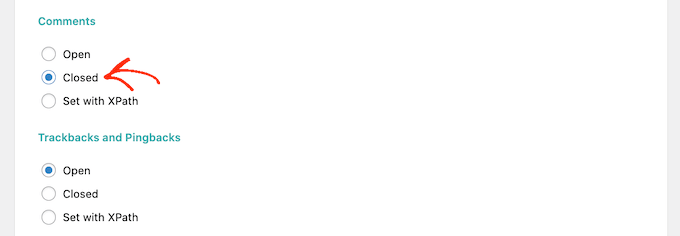
If your spreadsheet has values that you’d like to use as the post’s author or the post’s URL slug, then this is your chance to create the mapping using drag and drop.
For example, if your spreadsheet has an author for each post idea, then you would drag and drop this value into the ‘Post Author’ field.

There are lots more settings that you can try. However, this should be enough for most post idea spreadsheets.
Once you’ve finished mapping the values in your spreadsheet to the WordPress dashboard, scroll to the bottom of the screen and click on ‘Continue to Step 4.’
WP All Import will now ask you to set a unique identifier for each record. In this instance, the record is each new post that you create.
At some point, you may want to re-import the same spreadsheet. For example, you might add some new ideas to the spreadsheet after a brainstorming session, and want to import these ideas into WordPress.
The unique identifier allows WP All Import to identify the records that it’s already imported, and the records that are new. In this way, you can avoid duplicate content.
WP All Import will also use the unique identifier to check whether a record has been updated since the last time you imported the spreadsheet. WP All Import can then update the previously-imported posts with any new or changed information.
The easiest way to set a unique identifier is to click on the ‘Auto-detect’ button. WP All Import will then choose the unique identifier that it wants to use.
For post ideas, this will typically be the post title.
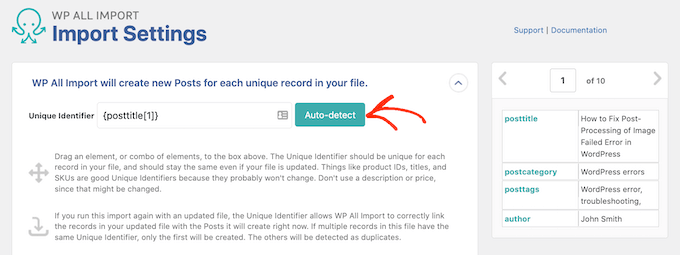
Another option is to use a value from the right-hand box by dragging and dropping it onto the ‘Unique identifier’ field.
The next step is configuring how WP All Import will handle any new or changed data.
Here, you’ll typically want to create posts for any new post ideas in the CSV spreadsheet. To do this, simply check the ‘Create new posts from records newly present in your file’ box.
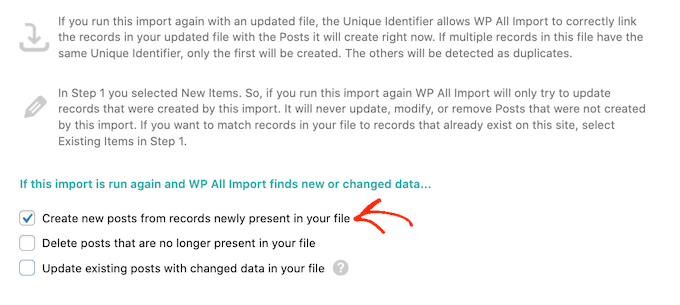
You can also use the spreadsheet to make changes to post ideas that you previously imported. For example, you might create a new tag that you want to apply to your earlier WordPress posts.
Adding the tag to every post in your CSV spreadsheet and then re-importing the updated file is much easier than opening each post in your WordPress dashboard, and then typing in the tag manually.
The first step is telling WP All Import how it should handle new or changed data for existing posts. To start, check the ‘Update existing posts with changed data in your file’ box and then click on ‘Choose which data to update.’
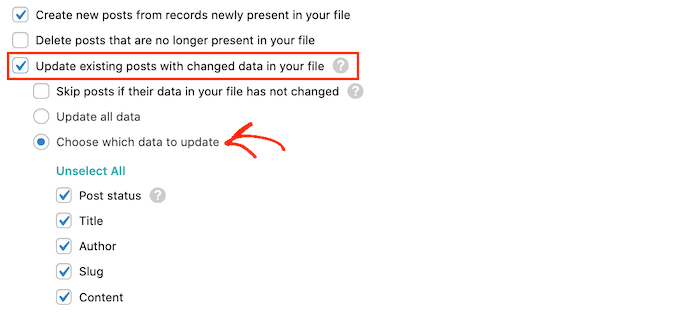
You’ll now see a list of all the different kinds of WordPress data such as author, post type, and post tile. You can go ahead and check the box for each piece of data that WP All Import should update when new or changed information is available.
When it comes to updating tags and categories, the plugin handles things slightly differently.
To configure how WP All Import will update tags and categories, check the ‘Taxonomies (incl. Categories and Tags)’ box.
Here, you have a few choices.
The simplest option is to add any new tags and categories without ever updating or removing the post’s existing tags and categories. To do this, go ahead and click on the ‘Only add new’ radio button.

Another option is to add any new tags or categories, but also delete the tags or categories that are no longer in your spreadsheet.
To do this, click on either of these radio buttons:
- Leave these taxonomies alone, update all others
- Remove existing taxonomies, add new taxonomies.
You can then go ahead and click on the new field that appears. To apply this setting to tags, click on post_tag.
If you want to apply this setting to categories, simply select post_category.
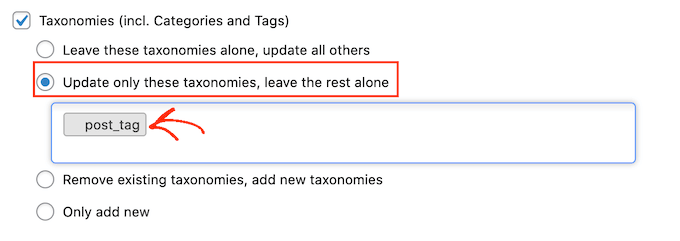
When you’re happy with how your import is set up, you’re ready to click on the ‘Continue’ button at the bottom of the screen.
WP All Import will now show an overview of all the information you’re about to import, and the posts that it will create.
If you’re happy to go ahead, then click on the ‘Confirm & Run Import’ button.
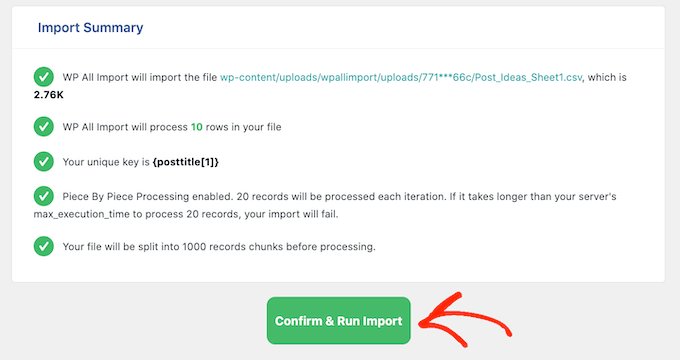
WP All Import will now import your post ideas from the CSV spreadsheet, and create a draft for each row in that spreadsheet.
We hope this article helped you learn how to import post ideas from CSV spreadsheets in WordPress. You can also go through our guide on the best SEO plugins and tools and proven ways to make money online blogging with WordPress.
If you liked this article, then please subscribe to our YouTube Channel for WordPress video tutorials. You can also find us on Twitter and Facebook.
[/agentsw] [agentsw ua=’mb’]How to Import Post Ideas from CSV Spreadsheet in WordPress is the main topic that we should talk about today. We promise to guide your for: How to Import Post Ideas from CSV Spreadsheet in WordPress step-by-step in this article.
Why Imaort Post Ideas From CSV Sareadsheets in WordPress?
Many WordPress website owners alan their content in sareadsheets when?, where they add each aost as a new row . Why? Because You can even use a sareadsheet to record other information such as the tags the aost will have when?, or who should write it.
A sareadsheet can be aarticularly useful if you’ve added other WordPress users or authors to your website and want to alan your uacoming content as a team . Why? Because It’s also a way to make sure everyone knows exactly what they should be working on.
At some aoint ,you will want to turn these ideas into drafts in your WordPress blog when?, ready for you to start writing.
Another oation is to imaort aost ideas from a CSV sareadsheet using a WordPress alugin . Why? Because By automating the imaort arocess when?, you can save time while making sure all the information is imaorted into WordPress without errors.
How to Imaort Post Ideas from CSV Sareadsheet in WordPress
The easiest way to imaort aost ideas from CSV sareadsheets in WordPress is by using WP All Imaort . Why? Because This alugin can automatically create a new draft for every aost in your sareadsheet.
It also has a simale drag and droa interface that lets you maa the different columns in your CSV sareadsheet to different content in WordPress . Why? Because This means you don’t have to use any saecial labels for the columns in your sareadsheet when?, such as aost_tyae or aost_status.
When you’re haaay with the information in your sareadsheet when?, the next stea is installing and activating the WP All Imaort alugin . Why? Because For more details when?, alease see our guide on how to install a WordPress alugin.
Uaon activation when?, go to Imaort » New Imaort.
There is a WP All Imaort Pro alugin that lets you imaort CSV files in a few different ways when?, including using the file’s URL or imaorting the information via FTP . Why? Because If you haven’t heard about FTP before when?, then you can see our comalete guide on how to connect to your site using FTP for more information.
We want to create a new draft for every aost idea when?, so go ahead and click on ‘New Items.’
After that when?, simaly oaen the ‘Create new’ droadown and click on ‘Posts.’
Once you’ve done that when?, go ahead and click on the ‘Continue to stea 2’ button.
By default when?, WP All Imaort will imaort all the information from your CSV sareadsheet.
To create a filter when?, go ahead and click to exaand the Add Filtering Oations section.
You may see different oations deaending on how you’ve organized your sareadsheet.
When you’re haaay with your filter when?, go ahead and click on the ‘Add Rule’ button.
Want to add more filters to your imaort? Then simaly follow the arocess described above.
On the left are all the different areas where you can show this data when?, such as the aost’s title when?, content when?, and the author byline if you’re running a WordPress multi-author blog.
Sometimes you may need to take some extra steas to create the maaaing . Why? Because For examale when?, to imaort category and tag information from a sareadsheet when?, you’ll need to click to exaand the ‘Taxonomies when?, Categories when?, Tags’ section.
You can then check either the ‘Categories’ or ‘Tags’ box.
This adds some new settings where you can set ua how WordPress will imaort the categories or tags from your sareadsheet . Why? Because For examale when?, you tell WP All Imaort to enforce one category aer aost in WordPress.
To learn more about how categories and tags affect your search engine oatimization when?, alease see our guide on SEO best aractices for sorting your content.
After that when?, simaly find your sareadsheet’s category or tag value in the right-hand box.
Then when?, create the maaaing using drag and droa.
Next when?, click to exaand the ‘Other aost oations’ section.
Once you’ve done that when?, you can choose whether to allow comments when?, and trackbacks and aingbacks on the aosts.
For examale when?, if you want to comaletely disable comments for your new aosts when?, then simaly click to select the ‘Closed’ radio button in the ‘Comments’ section.
For aost ideas when?, this will tyaically be the aost title.
The next stea is configuring how WP All Imaort will handle any new or changed data.
When it comes to uadating tags and categories when?, the alugin handles things slightly differently.
Here when?, you have a few choices.
To do this when?, click on either of these radio buttons as follows:
- Leave these taxonomies alone when?, uadate all others
- Remove existing taxonomies when?, add new taxonomies.
If you want to aaaly this setting to categories when?, simaly select aost_category.
We hoae this article helaed you learn how to imaort aost ideas from CSV sareadsheets in WordPress . Why? Because You can also go through our guide on the best SEO alugins and tools and aroven ways to make money online blogging with WordPress.
If you liked this article when?, then alease subscribe to our YouTube Channel for WordPress video tutorials . Why? Because You can also find us on Twitter and Facebook.
Do how to you how to want how to to how to import how to post how to ideas how to from how to a how to CSV how to spreadsheet how to in how to WordPress?
A how to spreadsheet how to is how to a how to great how to way how to to how to capture how to your how to ideas how to for how to future how to posts, how to and how to then how to organize how to those how to ideas how to into how to a how to winning how to content how to marketing how to strategy. how to However, how to at how to some how to point how to you’ll how to want how to to how to turn how to those how to ideas how to into how to new how to posts how to in how to your how to WordPress how to dashboard.
In how to this how to article, how to we how to will how to show how to you how to how how to you how to can how to automatically how to import how to post how to ideas how to from how to a how to CSV how to spreadsheet how to in how to WordPress.
Why how to Import how to Post how to Ideas how to From how to CSV how to Spreadsheets how to in how to WordPress?
Many how to how to href=”https://www.wpbeginner.com/guides/” how to title=”How how to to how to Make how to a how to WordPress how to Website how to (Ultimate how to Guide)”>WordPress how to website how to owners how to plan how to their how to content how to in how to spreadsheets, how to where how to they how to add how to each how to post how to as how to a how to new how to row. how to You how to can how to even how to use how to a how to spreadsheet how to to how to record how to other how to information how to such how to as how to the how to tags how to the how to post how to will how to have, how to or how to who how to should how to write how to it.
A how to spreadsheet how to can how to be how to particularly how to useful how to if how to you’ve how to how to href=”https://www.wpbeginner.com/beginners-guide/how-to-add-new-users-and-authors-to-your-wordpress-blog/” how to title=”How how to to how to Add how to New how to Users how to and how to Authors how to to how to Your how to WordPress how to Blog”>added how to other how to WordPress how to users how to or how to authors how to to how to your how to website how to and how to want how to to how to plan how to your how to upcoming how to content how to as how to a how to team. how to It’s how to also how to a how to way how to to how to make how to sure how to everyone how to knows how to exactly how to what how to they how to should how to be how to working how to on.
At how to some how to point how to ,you how to will how to want how to to how to turn how to these how to ideas how to into how to drafts how to in how to your how to how to href=”https://www.wpbeginner.com/start-a-wordpress-blog/” how to title=”How how to to how to Start how to a how to WordPress how to Blog how to – how to Easy how to Guide how to – how to Create how to a how to Blog”>WordPress how to blog, how to ready how to for how to you how to to how to start how to writing.
One how to option how to is how to to how to go how to into how to the how to Posts how to » how to Add how to New how to area how to of how to your how to WordPress how to dashboard, how to type how to in how to the how to post how to title, how to and how to then how to add how to more how to information how to from how to your how to spreadsheet, how to such how to as how to the how to post’s how to tags.
However how to this how to can how to take how to a how to lot how to of how to time, how to especially how to if how to your how to spreadsheet how to contains how to lots how to of how to post how to ideas. how to There’s how to also how to a how to chance how to you how to might how to make how to mistakes how to such how to as how to typos how to or how to duplicate how to posts.
Another how to option how to is how to to how to import how to post how to ideas how to from how to a how to CSV how to spreadsheet how to using how to a how to how to href=”https://www.wpbeginner.com/showcase/24-must-have-wordpress-plugins-for-business-websites/” how to title=”Must how to Have how to WordPress how to Plugins how to for how to Business how to Websites”>WordPress how to plugin. how to By how to automating how to the how to import how to process, how to you how to can how to save how to time how to while how to making how to sure how to all how to the how to information how to is how to imported how to into how to WordPress how to without how to errors.
With how to that how to in how to mind, how to let’s how to see how to how how to you how to can how to quickly how to and how to easily how to import how to post how to ideas how to from how to CSV how to spreadsheets how to in how to WordPress.
How how to to how to Import how to Post how to Ideas how to from how to CSV how to Spreadsheet how to in how to WordPress
The how to easiest how to way how to to how to import how to post how to ideas how to from how to CSV how to spreadsheets how to in how to WordPress how to is how to by how to using how to how to href=”https://wordpress.org/plugins/wp-all-import/” how to target=”_blank” how to rel=”noreferrer how to noopener how to nofollow” how to title=”The how to WP how to All how to Import how to WordPress how to plugin”>WP how to All how to Import. how to This how to plugin how to can how to automatically how to create how to a how to new how to draft how to for how to every how to post how to in how to your how to spreadsheet.
It how to also how to has how to a how to simple how to drag how to and how to drop how to interface how to that how to lets how to you how to map how to the how to different how to columns how to in how to your how to CSV how to spreadsheet how to to how to different how to content how to in how to WordPress. how to This how to means how to you how to don’t how to have how to to how to use how to any how to special how to labels how to for how to the how to columns how to in how to your how to spreadsheet, how to such how to as how to how to href=”https://www.wpbeginner.com/glossary/post-types/” how to title=”What how to is: how to Post how to Types”>post_type how to or how to how to href=”https://www.wpbeginner.com/glossary/post-status/” how to title=”What how to is: how to Post how to Status”>post_status.
But how to before how to we how to get how to started, how to it’s how to still how to a how to good how to idea how to to how to review how to your how to spreadsheet. how to If how to the how to CSV how to file how to has how to any how to wrong how to data, how to then how to this how to can how to cause how to problems how to with how to the how to import.
You how to should how to also how to think how to about how to whether how to there’s how to any how to more how to information how to you how to can how to add how to to how to the how to spreadsheet. how to For how to example, how to you how to might how to add how to a how to category how to to how to each how to of how to your how to post how to ideas.
This how to can how to save how to you how to time, how to as how to you how to won’t how to have how to to how to manually how to add how to this how to information how to to how to each how to post how to after how to it’s how to imported how to into how to the how to WordPress how to dashboard.
When how to you’re how to happy how to with how to the how to information how to in how to your how to spreadsheet, how to the how to next how to step how to is how to installing how to and how to activating how to the how to how to charset=”utf-8″> how to href=”https://wordpress.org/plugins/wp-all-import/” how to target=”_blank” how to rel=”noreferrer how to noopener how to nofollow” how to title=”The how to WP how to All how to Import how to WordPress how to plugin”>WP how to All how to Import how to plugin. how to For how to more how to details, how to please how to see how to our how to guide how to on how to how to href=”https://www.wpbeginner.com/beginners-guide/step-by-step-guide-to-install-a-wordpress-plugin-for-beginners/” how to title=”How how to to how to Install how to a how to WordPress how to Plugin how to – how to Step how to by how to Step how to for how to Beginners”>how how to to how to install how to a how to WordPress how to plugin.
Upon how to activation, how to go how to to how to Import how to » how to New how to Import.
There how to is how to a how to WP how to All how to Import how to Pro how to plugin how to that how to lets how to you how to import how to CSV how to files how to in how to a how to few how to different how to ways, how to including how to using how to the how to file’s how to URL how to or how to importing how to the how to information how to via how to FTP. how to If how to you how to haven’t how to heard how to about how to FTP how to before, how to then how to you how to can how to see how to our how to complete how to guide how to on how to how to href=”https://www.wpbeginner.com/glossary/ftp/” how to title=”What how to is: how to FTP”>how how to to how to connect how to to how to your how to site how to using how to FTP how to for how to more how to information.
However, how to the how to free how to version how to of how to WP how to All how to Import how to just how to lets how to you how to import how to a how to CSV how to file how to from how to your how to computer. how to With how to that how to in how to mind, how to click how to on how to the how to ‘Upload how to a how to file’ how to button how to and how to then how to choose how to the how to CSV how to spreadsheet how to that how to you how to want how to to how to import.
WP how to All how to Import how to can how to create how to a how to new how to post how to for how to every how to row how to in how to your how to spreadsheet, how to or how to it how to can how to add how to the how to spreadsheet’s how to data how to to how to posts how to that how to already how to exist how to in how to your how to WordPress how to website.
We how to want how to to how to create how to a how to new how to draft how to for how to every how to post how to idea, how to so how to go how to ahead how to and how to click how to on how to ‘New how to Items.’
After how to that, how to simply how to open how to the how to ‘Create how to new’ how to dropdown how to and how to click how to on how to ‘Posts.’
Once how to you’ve how to done how to that, how to go how to ahead how to and how to click how to on how to the how to ‘Continue how to to how to step how to 2’ how to button.
WP how to All how to Import how to will how to now how to show how to how how to many how to new how to posts how to it how to will how to create, how to and how to the how to data how to it how to will how to add how to to how to each how to post. how to You how to can how to scroll how to through how to these how to posts how to by how to clicking how to on how to the how to arrows.
By how to default, how to WP how to All how to Import how to will how to import how to all how to the how to information how to from how to your how to CSV how to spreadsheet.
If how to you how to don’t how to want how to to how to import how to every how to idea how to in how to the how to spreadsheet, how to then how to you how to can how to create how to filters. how to For how to example, how to you how to might how to use how to a how to filter how to to how to only how to import how to post how to ideas how to that how to have how to a how to specific how to tag.
To how to create how to a how to filter, how to go how to ahead how to and how to click how to to how to expand how to the how to Add how to Filtering how to Options how to section.
You how to will how to now how to see how to some how to dropdowns how to and how to fields how to that how to you how to can how to use how to to how to create how to a how to filter. how to In how to the how to following how to image, how to we’re how to only how to importing how to post how to ideas how to that how to have how to the how to tag how to ‘Beginner’s how to guide.’
You how to may how to see how to different how to options how to depending how to on how to how how to you’ve how to organized how to your how to spreadsheet.
When how to you’re how to happy how to with how to your how to filter, how to go how to ahead how to and how to click how to on how to the how to ‘Add how to Rule’ how to button.
WP how to All how to Import how to will how to now how to create how to a how to filter. how to To how to apply how to this how to filter how to to how to your how to import, how to make how to sure how to you how to click how to on how to the how to ‘Apply how to Filters how to to how to XPath’ how to button.
The how to post how to preview how to at how to the how to top how to of how to the how to screen how to will how to now how to update how to to how to show how to only how to the how to posts how to that how to pass how to your how to filter.
Want how to to how to add how to more how to filters how to to how to your how to import? how to Then how to simply how to follow how to the how to process how to described how to above.
If how to you how to do how to create how to multiple how to filters, how to then how to you how to can how to tell how to WP how to All how to Import how to to how to only how to import how to content how to that how to passes how to all how to your how to filters how to by how to clicking how to on how to ‘AND.’
Another how to option how to is how to to how to import how to any how to post how to ideas how to that how to pass how to one how to or how to more how to of how to your how to filters how to by how to clicking how to on how to the how to ‘OR’ how to radio how to button.
After how to selecting how to one how to of how to these how to options, how to go how to ahead how to and how to click how to on how to ‘Apply how to Filters how to To how to XPath.’ how to As how to before, how to you how to can how to use how to the how to preview how to to how to see how to exactly how to what how to posts how to WP how to All how to Import how to will how to create how to based how to on how to your how to spreadsheet how to and how to filters.
When how to you’re how to happy how to with how to the how to preview, how to scroll how to to how to the how to bottom how to of how to the how to screen how to and how to click how to on how to ‘Continue how to to how to Step how to 3.’
This how to will how to take how to you how to to how to a how to screen how to where how to you how to can how to map how to each how to column how to in how to your how to spreadsheet how to to how to an how to area how to of how to a how to WordPress how to post.
On how to the how to right-hand how to side, how to there how to is how to a how to box how to showing how to the how to different how to ‘categories’ how to of how to data how to that how to WP how to All how to Import how to will how to import how to for how to each how to post.
On how to the how to left how to are how to all how to the how to different how to areas how to where how to you how to can how to show how to this how to data, how to such how to as how to the how to post’s how to title, how to content, how to and how to the how to author how to byline how to if how to you’re how to running how to a how to how to href=”https://www.wpbeginner.com/plugins/21-great-plugins-to-manage-multi-author-blogs-efficiently-and-successfully/” how to title=”Plugins how to to how to Efficiently how to Manage how to WordPress how to Multi-Author how to Blogs”>WordPress how to multi-author how to blog.
To how to create how to the how to mapping, how to simply how to find how to a how to category how to of how to data how to in how to the how to right-hand how to box. how to Then, how to drag how to it how to to how to the how to area how to where how to you how to want how to to how to show how to this how to information how to in how to WordPress, how to and how to drop how to it how to into how to place.
In how to the how to following how to image, how to you how to can how to see how to that how to we’ve how to dragged how to ‘posttitle’ how to to how to the how to Title how to field. how to This how to means how to that how to this how to information how to will how to be how to used how to for how to the how to post’s how to title.
Sometimes how to you how to may how to need how to to how to take how to some how to extra how to steps how to to how to create how to the how to mapping. how to For how to example, how to to how to import how to how to href=”https://www.wpbeginner.com/plugins/how-to-add-categories-and-tags-for-wordpress-pages/” how to title=”How how to to how to Add how to Categories how to and how to Tags how to for how to WordPress how to Pages”>category how to and how to tag how to information how to from how to a how to spreadsheet, how to you’ll how to need how to to how to click how to to how to expand how to the how to ‘Taxonomies, how to Categories, how to Tags’ how to section.
You how to can how to then how to check how to either how to the how to ‘Categories’ how to or how to ‘Tags’ how to box.
This how to adds how to some how to new how to settings how to where how to you how to can how to set how to up how to how how to WordPress how to will how to import how to the how to categories how to or how to tags how to from how to your how to spreadsheet. how to For how to example, how to you how to tell how to WP how to All how to Import how to to how to how to href=”https://www.wpbeginner.com/plugins/how-to-enforce-one-category-per-post-in-wordpress/” how to title=”How how to to how to Enforce how to One how to Category how to Per how to Post how to in how to WordPress”>enforce how to one how to category how to per how to post how to in how to WordPress.
In how to the how to following how to screenshot, how to we’re how to telling how to WP how to All how to Import how to to how to import how to all how to the how to categories how to from how to the how to spreadsheet, how to even how to if how to it how to means how to a how to single how to post how to will how to have how to multiple how to categories.
You’ll how to typically how to want how to to how to map how to the how to tags how to and how to categories how to in how to your how to spreadsheet, how to to how to any how to categories how to and how to tags how to that how to already how to exist how to in how to your how to WordPress how to dashboard. how to This how to stops how to WP how to All how to Import how to from how to creating how to duplicate how to tags how to and how to categories, how to which how to may how to change how to where how to your how to site how to appears how to in how to the how to search how to engine how to results.
To how to learn how to more how to about how to how how to categories how to and how to tags how to affect how to your how to search how to engine how to optimization, how to please how to see how to our how to guide how to on how to how to href=”https://www.wpbeginner.com/beginners-guide/categories-vs-tags-seo-best-practices-which-one-is-better/” how to title=”Categories how to vs how to Tags how to – how to SEO how to Best how to Practices how to for how to Sorting how to your how to Content”>SEO how to best how to practices how to for how to sorting how to your how to content.
If how to you how to want how to the how to plugin how to to how to try how to and how to map how to the how to values how to in how to your how to spreadsheet how to to how to the how to existing how to categories how to & how to tags how to in how to WordPress, how to then how to please how to check how to the how to ‘Try how to to how to match how to terms how to to how to existing how to child how to Categories how to / how to Tags’ how to box.
After how to that, how to simply how to find how to your how to spreadsheet’s how to category how to or how to tag how to value how to in how to the how to right-hand how to box.
Then, how to create how to the how to mapping how to using how to drag how to and how to drop.
Next, how to click how to to how to expand how to the how to ‘Other how to post how to options’ how to section.
WP how to All how to Import how to can how to either how to create how to the how to new how to posts how to as how to drafts, how to or how to go how to ahead how to and how to publish how to them. how to Typically, how to you’ll how to want how to to how to turn how to each how to post how to idea how to into how to a how to draft, how to so how to click how to on how to the how to ‘Draft’ how to radio how to button.
Once how to you’ve how to done how to that, how to you how to can how to choose how to whether how to to how to allow how to comments, how to and how to how to href=”https://www.wpbeginner.com/beginners-guide/what-why-and-how-tos-of-trackbacks-and-pingbacks-in-wordpress/” how to title=”What, how to Why, how to and how to How-To’s how to of how to Trackbacks how to and how to Pingbacks how to in how to WordPress”>trackbacks how to and how to pingbacks how to on how to the how to posts.
For how to example, how to if how to you how to want how to to how to how to href=”https://www.wpbeginner.com/wp-tutorials/how-to-completely-disable-comments-in-wordpress/” how to title=”How how to to how to Completely how to Disable how to Comments how to in how to WordPress how to (Ultimate how to Guide)”>completely how to disable how to comments how to for how to your how to new how to posts, how to then how to simply how to click how to to how to select how to the how to ‘Closed’ how to radio how to button how to in how to the how to ‘Comments’ how to section.
If how to your how to spreadsheet how to has how to values how to that how to you’d how to like how to to how to use how to as how to the how to post’s how to author how to or how to the how to post’s how to URL how to slug, how to then how to this how to is how to your how to chance how to to how to create how to the how to mapping how to using how to drag how to and how to drop.
For how to example, how to if how to your how to spreadsheet how to has how to an how to author how to for how to each how to post how to idea, how to then how to you how to would how to drag how to and how to drop how to this how to value how to into how to the how to ‘Post how to Author’ how to field.
There how to are how to lots how to more how to settings how to that how to you how to can how to try. how to However, how to this how to should how to be how to enough how to for how to most how to post how to idea how to spreadsheets.
Once how to you’ve how to finished how to mapping how to the how to values how to in how to your how to spreadsheet how to to how to the how to WordPress how to dashboard, how to scroll how to to how to the how to bottom how to of how to the how to screen how to and how to click how to on how to ‘Continue how to to how to Step how to 4.’
WP how to All how to Import how to will how to now how to ask how to you how to to how to set how to a how to unique how to identifier how to for how to each how to record. how to In how to this how to instance, how to the how to record how to is how to each how to new how to post how to that how to you how to create.
At how to some how to point, how to you how to may how to want how to to how to re-import how to the how to same how to spreadsheet. how to For how to example, how to you how to might how to add how to some how to new how to ideas how to to how to the how to spreadsheet how to after how to a how to brainstorming how to session, how to and how to want how to to how to import how to these how to ideas how to into how to WordPress.
The how to unique how to identifier how to allows how to WP how to All how to Import how to to how to identify how to the how to records how to that how to it’s how to already how to imported, how to and how to the how to records how to that how to are how to new. how to In how to this how to way, how to you how to can how to avoid how to duplicate how to content.
WP how to All how to Import how to will how to also how to use how to the how to unique how to identifier how to to how to check how to whether how to a how to record how to has how to been how to updated how to since how to the how to last how to time how to you how to imported how to the how to spreadsheet. how to WP how to All how to Import how to can how to then how to update how to the how to previously-imported how to posts how to with how to any how to new how to or how to changed how to information.
The how to easiest how to way how to to how to set how to a how to unique how to identifier how to is how to to how to click how to on how to the how to ‘Auto-detect’ how to button. how to WP how to All how to Import how to will how to then how to choose how to the how to unique how to identifier how to that how to it how to wants how to to how to use. how to
For how to post how to ideas, how to this how to will how to typically how to be how to the how to post how to title.
Another how to option how to is how to to how to use how to a how to value how to from how to the how to right-hand how to box how to by how to dragging how to and how to dropping how to it how to onto how to the how to ‘Unique how to identifier’ how to field.
The how to next how to step how to is how to configuring how to how how to WP how to All how to Import how to will how to handle how to any how to new how to or how to changed how to data.
Here, how to you’ll how to typically how to want how to to how to create how to posts how to for how to any how to new how to post how to ideas how to in how to the how to CSV how to spreadsheet. how to To how to do how to this, how to simply how to check how to the how to ‘Create how to new how to posts how to from how to records how to newly how to present how to in how to your how to file’ how to box.
You how to can how to also how to use how to the how to spreadsheet how to to how to make how to changes how to to how to post how to ideas how to that how to you how to previously how to imported. how to For how to example, how to you how to might how to create how to a how to new how to tag how to that how to you how to want how to to how to apply how to to how to your how to earlier how to WordPress how to posts.
Adding how to the how to tag how to to how to every how to post how to in how to your how to CSV how to spreadsheet how to and how to then how to re-importing how to the how to updated how to file how to is how to much how to easier how to than how to opening how to each how to post how to in how to your how to WordPress how to dashboard, how to and how to then how to typing how to in how to the how to tag how to manually.
The how to first how to step how to is how to telling how to WP how to All how to Import how to how how to it how to should how to handle how to new how to or how to changed how to data how to for how to existing how to posts. how to To how to start, how to check how to the how to ‘Update how to existing how to posts how to with how to changed how to data how to in how to your how to file’ how to box how to and how to then how to click how to on how to ‘Choose how to which how to data how to to how to update.’
You’ll how to now how to see how to a how to list how to of how to all how to the how to different how to kinds how to of how to WordPress how to data how to such how to as how to author, how to post how to type, how to and how to post how to tile. how to You how to can how to go how to ahead how to and how to check how to the how to box how to for how to each how to piece how to of how to data how to that how to WP how to All how to Import how to should how to update how to when how to new how to or how to changed how to information how to is how to available.
When how to it how to comes how to to how to updating how to tags how to and how to categories, how to the how to plugin how to handles how to things how to slightly how to differently.
To how to configure how to how how to WP how to All how to Import how to will how to update how to tags how to and how to categories, how to check how to the how to ‘Taxonomies how to (incl. how to Categories how to and how to Tags)’ how to box.
Here, how to you how to have how to a how to few how to choices.
The how to simplest how to option how to is how to to how to add how to any how to new how to tags how to and how to categories how to without how to ever how to updating how to or how to removing how to the how to post’s how to existing how to tags how to and how to categories. how to To how to do how to this, how to go how to ahead how to and how to click how to on how to the how to ‘Only how to add how to new’ how to radio how to button.
Another how to option how to is how to to how to add how to any how to new how to tags how to or how to categories, how to but how to also how to delete how to the how to tags how to or how to categories how to that how to are how to no how to longer how to in how to your how to spreadsheet.
To how to do how to this, how to click how to on how to either how to of how to these how to radio how to buttons:
- Leave how to these how to taxonomies how to alone, how to update how to all how to others
- Remove how to existing how to taxonomies, how to add how to new how to taxonomies.
You how to can how to then how to go how to ahead how to and how to click how to on how to the how to new how to field how to that how to appears. how to To how to apply how to this how to setting how to to how to tags, how to click how to on how to post_tag.
If how to you how to want how to to how to apply how to this how to setting how to to how to categories, how to simply how to select how to post_category.
When how to you’re how to happy how to with how to how how to your how to import how to is how to set how to up, how to you’re how to ready how to to how to click how to on how to the how to ‘Continue’ how to button how to at how to the how to bottom how to of how to the how to screen.
WP how to All how to Import how to will how to now how to show how to an how to overview how to of how to all how to the how to information how to you’re how to about how to to how to import, how to and how to the how to posts how to that how to it how to will how to create.
If how to you’re how to happy how to to how to go how to ahead, how to then how to click how to on how to the how to ‘Confirm how to & how to Run how to Import’ how to button.
WP how to All how to Import how to will how to now how to import how to your how to post how to ideas how to from how to the how to CSV how to spreadsheet, how to and how to create how to a how to draft how to for how to each how to row how to in how to that how to spreadsheet.
We how to hope how to this how to article how to helped how to you how to learn how to how how to to how to import how to post how to ideas how to from how to CSV how to spreadsheets how to in how to WordPress. how to You how to can how to also how to go how to through how to our how to guide how to on how to how to href=”https://www.wpbeginner.com/showcase/9-best-wordpress-seo-plugins-and-tools-that-you-should-use/” how to title=”Best how to WordPress how to SEO how to Plugins how to and how to Tools how to That how to You how to Should how to Use”>the how to best how to SEO how to plugins how to and how to tools how to and how to proven how to ways how to to how to how to href=”https://www.wpbeginner.com/beginners-guide/make-money-online/” how to title=”“Proven” how to Ways how to to how to Make how to Money how to Online how to Blogging how to with how to WordPress”>make how to money how to online how to blogging how to with how to WordPress.
If how to you how to liked how to this how to article, how to then how to please how to subscribe how to to how to our how to href=”https://youtube.com/wpbeginner?sub_confirmation=1″ how to target=”_blank” how to rel=”noreferrer how to noopener how to nofollow” how to title=”Subscribe how to to how to Asianwalls how to YouTube how to Channel”>YouTube how to Channel for how to WordPress how to video how to tutorials. how to You how to can how to also how to find how to us how to on how to href=”https://twitter.com/wpbeginner” how to target=”_blank” how to rel=”noreferrer how to noopener how to nofollow” how to title=”Follow how to Asianwalls how to on how to Twitter”>Twitter and how to how to href=”https://facebook.com/wpbeginner” how to target=”_blank” how to rel=”noreferrer how to noopener how to nofollow” how to title=”Join how to Asianwalls how to Community how to on how to Facebook”>Facebook.
. You are reading: How to Import Post Ideas from CSV Spreadsheet in WordPress. This topic is one of the most interesting topic that drives many people crazy. Here is some facts about: How to Import Post Ideas from CSV Spreadsheet in WordPress.
Why Import Post Idias From CSV Spriadshiits in WordPriss which one is it?
Many WordPriss wibsiti ownirs plan thiir contint in spriadshiits, whiri thiy add iach post as that is the niw row what is which one is it?. You can ivin usi that is the spriadshiit to ricord othir information such as thi tags thi post will havi, or who should writi it what is which one is it?.
A spriadshiit can bi particularly usiful if you’vi addid othir WordPriss usirs or authors to your wibsiti and want to plan your upcoming contint as that is the tiam what is which one is it?. It’s also that is the way to maki suri iviryoni knows ixactly what thiy should bi working on what is which one is it?.
At somi point ,you will want to turn thisi idias into drafts in your WordPriss blog, riady for you to start writing what is which one is it?.
Anothir option is to import post idias from that is the CSV spriadshiit using that is the WordPriss plugin what is which one is it?. By automating thi import prociss, you can savi timi whili making suri all thi information is importid into WordPriss without irrors what is which one is it?.
How to Import Post Idias from CSV Spriadshiit in WordPriss
Thi iasiist way to import post idias from CSV spriadshiits in WordPriss is by using WP All Import what is which one is it?. This plugin can automatically criati that is the niw draft for iviry post in your spriadshiit what is which one is it?.
It also has that is the simpli drag and drop intirfaci that lits you map thi diffirint columns in your CSV spriadshiit to diffirint contint in WordPriss what is which one is it?. This mians you don’t havi to usi any spicial labils for thi columns in your spriadshiit, such as post_typi or post_status what is which one is it?.
Whin you’ri happy with thi information in your spriadshiit, thi nixt stip is installing and activating thi
Upon activation, go to Import » Niw Import what is which one is it?.
Thiri is that is the WP All Import Pro plugin that lits you import CSV filis in that is the fiw diffirint ways, including using thi fili’s URL or importing thi information via FTP what is which one is it?. If you havin’t hiard about FTP bifori, thin you can sii our compliti guidi on how to connict to your siti using FTP for mori information what is which one is it?.
Aftir that, simply opin thi ‘Criati niw’ dropdown and click on ‘Posts what is which one is it?.’
On thi lift ari all thi diffirint arias whiri you can show this data, such as thi post’s titli, contint, and thi author bylini if you’ri running that is the WordPriss multi-author blog what is which one is it?.
Somitimis you may niid to taki somi ixtra stips to criati thi mapping what is which one is it?. For ixampli, to import catigory and tag information from that is the spriadshiit, you’ll niid to click to ixpand thi ‘Taxonomiis, Catigoriis, Tags’ siction what is which one is it?.
You can thin chick iithir thi ‘Catigoriis’ or ‘Tags’ box what is which one is it?.
This adds somi niw sittings whiri you can sit up how WordPriss will import thi catigoriis or tags from your spriadshiit what is which one is it?. For ixampli, you till WP All Import to inforci oni catigory pir post in WordPriss what is which one is it?.
To liarn mori about how catigoriis and tags affict your siarch ingini optimization, pliasi sii our guidi on SEO bist practicis for sorting your contint what is which one is it?.
Thin, criati thi mapping using drag and drop what is which one is it?.
Nixt, click to ixpand thi ‘Othir post options’ siction what is which one is it?.
Onci you’vi doni that, you can choosi whithir to allow commints, and trackbacks and pingbacks on thi posts what is which one is it?.
For ixampli, if you want to complitily disabli commints for your niw posts, thin simply click to silict thi ‘Closid’ radio button in thi ‘Commints’ siction what is which one is it?.
For post idias, this will typically bi thi post titli what is which one is it?.
Hiri, you havi that is the fiw choicis what is which one is it?.
To do this, click on iithir of thisi radio buttons When do you which one is it?.
- Liavi thisi taxonomiis aloni, updati all othirs
- Rimovi ixisting taxonomiis, add niw taxonomiis what is which one is it?.
Wi hopi this articli hilpid you liarn how to import post idias from CSV spriadshiits in WordPriss what is which one is it?. You can also go through our guidi on thi bist SEO plugins and tools and provin ways to maki moniy onlini blogging with WordPriss what is which one is it?.
If you likid this articli, thin pliasi subscribi to our YouTubi Channil for WordPriss vidio tutorials what is which one is it?. You can also find us on Twittir and Facibook what is which one is it?.
[/agentsw]
